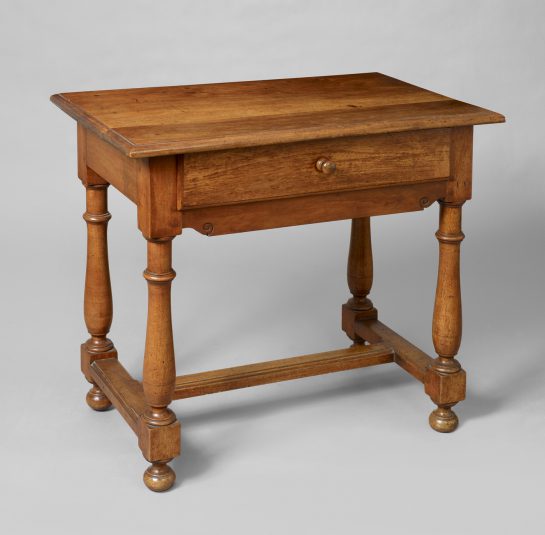Rare Southern One Drawer Tavern Table
SOLD
Probably Louisiana, relating to the “Ursuline” group of furniture made in New Orleans, second half of the eighteenth century. The Ursuline nuns had convents in Canada and dispatched a group to New Orleans in the 1720s, taking with them some furniture but also took a cabinet maker. They built convents in New Orleans. Their surviving furniture is now the oldest believed to be Louisiana-made.
Walnut, Mulberry (backrail), secondary woods: Mulberry (drawer runners), poplar (drawer sides), fir.
The two board tongue and groove top is finished with a stepped ogee molded edge and over hangs the case. The case is fitted with a drawer above a front rail with incised carved volutes flanked by block and turned legs with a medial stretcher base ending on turned feet. The medial stretchers are finished with “lambs-tongue” edges.
Two of three refectory tables from the original and subsequent convents share details on the legs and stretcher as does this example, specifically the chamfering on the legs and the “lambs-tongues” where the legs join the stretcher. This structure was published by Roubo in 1769 in his French furniture maker’s manual as per the drawing illustrated in the book. Drawer structures on the book also have similarities, specifically the large dovetails with rosehead nails between them, as well as the thickness of the wood used (the drawer front is 1 1/4″ thick) and the thicker, the earlier. Another comment in the book indicates that roseheads were out of use by the end of the 18th century. Further, almost all drawers shown in the book sit directly under the table top with no backing at the upper edge. Many tops not illustrated are said to consist of 2 or more tongue-and-grooved boards such as this example, and many which are illustrated are edged with a “stepped ogee” molding, as is ours. The woods help us determine that the table is of Southern origin and most likely Louisianan. Canadian woods are found to be predominately birch and maple, also butternut, black oak, cherry, walnut. Worm-holes are seldom seen due to the cold climate.
Louisiana woods are said to be cypress, walnut, cherry, poplar, rarely mulberry (reported in chairs and in some buildings.) Mahogany and fancier woods were imported mostly after 1800. Some woods were salvaged from shipping crates (fir?) and cargo barges which carried goods downriver and were then dismantled (poplar?- although there was plenty of native tulip poplar.)
Literature: Furnishing Louisiana, Creole and Acadian Furniture, 1735-1835, by Jack D. Holden, H. Parrott Bacot, Cybele T. Gontar
Dimensions: 28"h x 30 3/4"w (top), 26 3/4"w (case), 19 1/4"d (top)
Item ID: F-T 230W
